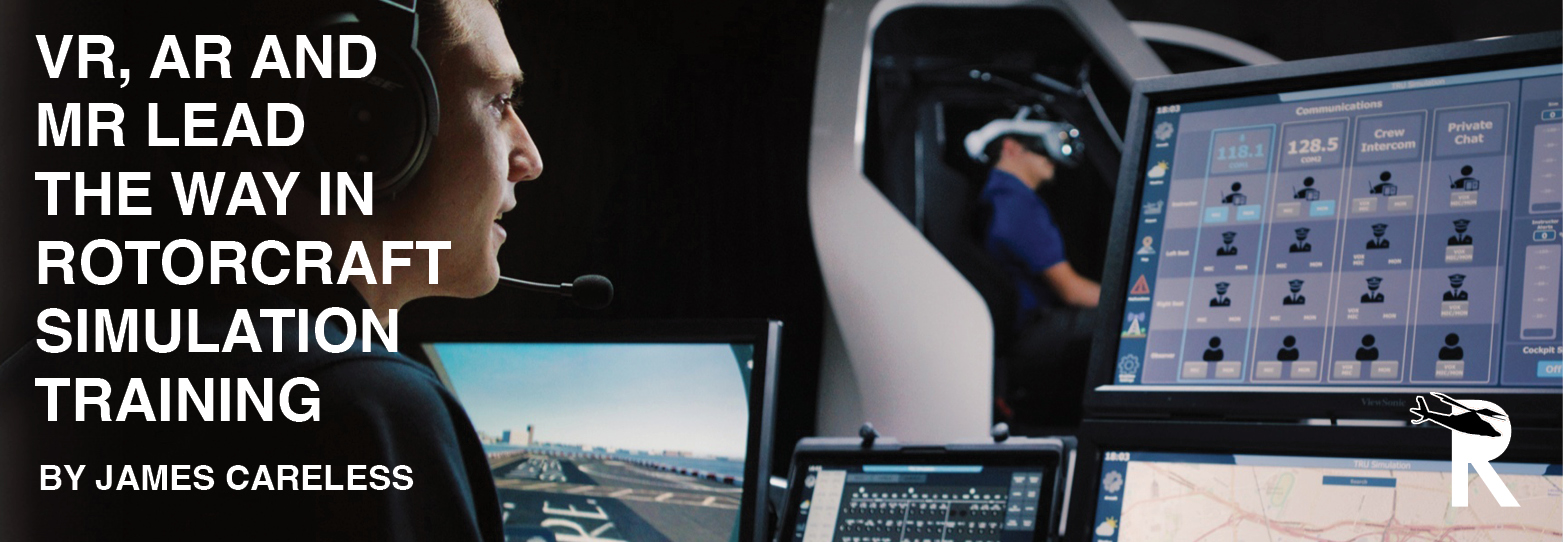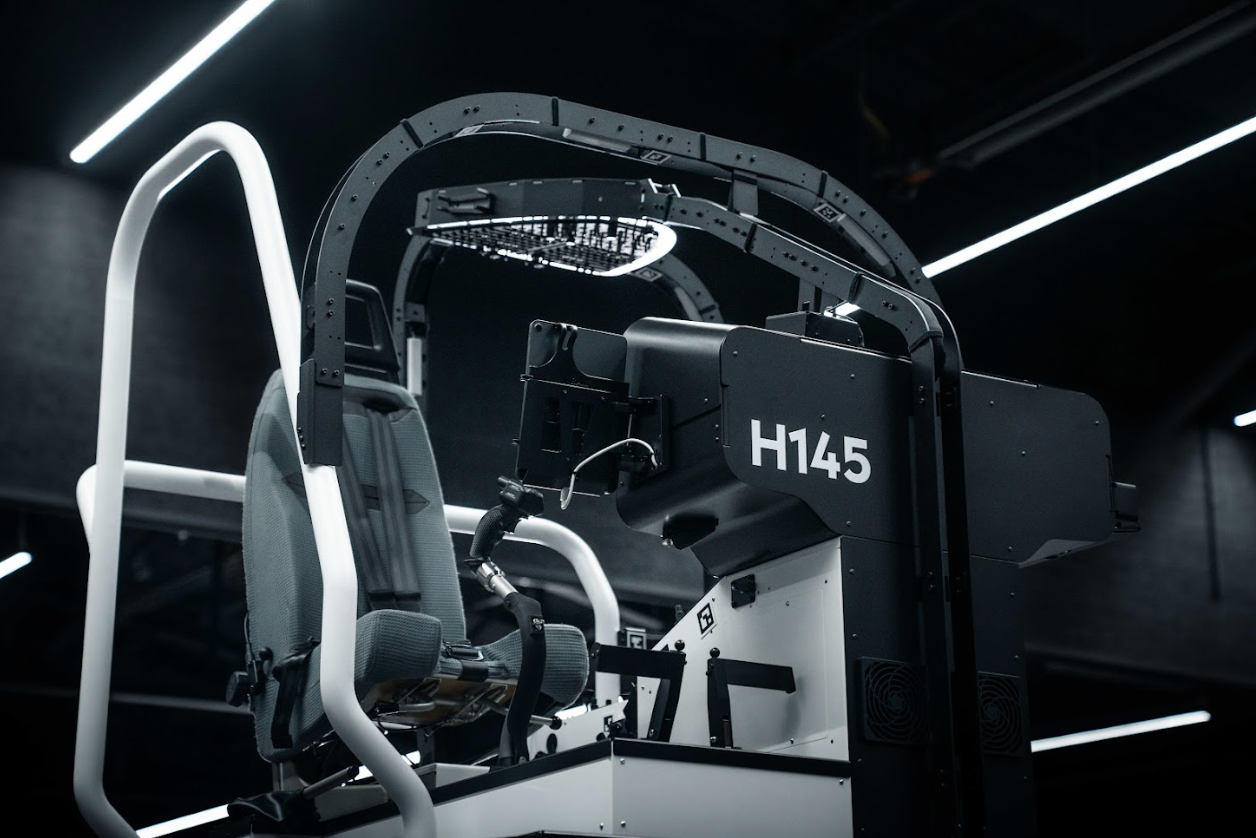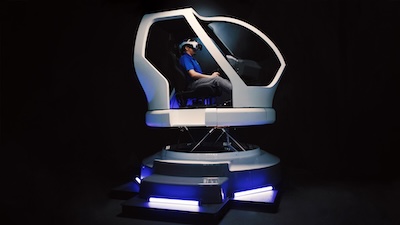|
Jun
23
2025
|
|
Posted 175 days ago ago by Admin
|
|

VR, AR, and MR: These are the trends dominating and driving simulation-based rotorcraft training today.
Definition time: VR stands for virtual reality, which fully immerses the user inside a digital environment. AR is short for augmented reality, where the user’s real-world field of view is overlaid with digital imagery. And MR stands for mixed reality, where users can physically interact with actual items in either a VR or AR environment.
Here’s how the rotorcraft industry is using VR, AR and MR for simulation-based training, at six cutting-edge companies.
Bluedrop Training & Simulation Inc.
Bluedrop Training & Simulation is a training organization that specializes in VR/MR simulation training for helicopter rear crew members. “With our state-of-the-art VR/MR rear crew mission trainer (RCMT) and its hoist mission training system (HMTS), Bluedrop is in effect transforming rear crew training,” said Jean-Claude Siew, Bluedrop’s EVP of Technology and Simulation.
Bluedrop does this by creating rear crew training enclosures that basically mimic the shape, layout and control surfaces of a standard helicopter. This use of haptic (touch-based) interactive training in tandem with VR/MR imagery displayed in the user’s immersive headsets, provides a training scenario that feels as real as it looks and sounds.
For example, “the dynamic response of the hoist cable, for example, is second-to-none and is so realistic that trainees feel completely immersed in the training scenarios,” Siew said. “The quality of the visual system and real-time response can provide training scenarios anywhere in the world and on any type of terrain and in any environmental conditions.
“At the same time, Bluedrop’s system provides a training environment that provides real-time feedback for both the trainee and the trainer. This capability is made possible by the capture of relevant performance data during the training process, which makes it easy for both to see how well the training session went and what skills remain to be mastered. This type of training improves proficiency and saves blade hours, provides safe emergency procedures training in difficult situations and environments, and provides confidence that the helicopter hoist operators are ready and have the skills for any situation,” concluded Siew.
Entrol
Entrol builds a full range of simulators for fixed-wing and rotorcraft training, the latter in support of pilots and rear-crew equipment operators.

Entrol's hoist operator mixed reality station. Credit Entrol
“We work with mixed-reality (MR) technology for mission training,” said Nacho Navacerrada, Entrol’s sales director. The reason? “When training with MR goggles, you can look down and better perceive the distance between the helicopter and the terrain,” he replied. “This is great when loading the Bambi bucket, transporting cargo with a long cable, or carrying out a SAR mission.”
At present, Entrol prefers to have students use its MR goggles without Chromakey image replacements that block out the wearer’s field of vision, so that they can use them in tandem with LED screens and video projection systems. “In this way, the trainers can use the LED/projectors for IFR, MCC, and procedures, which in multi-engine helicopters involve managing cockpit and systems training,” Navacerrada said.
As far as Entrol is concerned, MR flight simulations are a complement to actual flight training, not a replacement. “Synthetic training allows you to perform emergencies you cannot do on a helicopter,” said Navacerrada. “Nothing can replicate 100% the feeling of the actual flight, but the point of the simulators is to complement that and practice emergency situations and missions in a safe and pedagogical environment. They are also an excellent tool for experienced pilots to transfer knowledge to new ones, especially for mission situations such as firefighting and SAR, which cannot be recreated in real life.”
Frasca International
Frasca International designs and builds high-fidelity flight simulators for fixed-wing and rotorcraft training. And, like others in the industry, Frasca uses MR as an effective, affordable flight training option.
A case in point: Frasca recently delivered the last of 12 TH-73A cockpit-style, fixed-position MR training devices to Chief of Naval Air Training (CNATRA) and Training Wing 5 at NAS Whiting Field. “While many VR and MR applications are geared for single seat fighter and fixed-wing aircraft, these devices were one of the first rotary-wing devices that incorporated dual head-mounted displays (HMDs), so that both pilot and copilot could use the HMDs simultaneously,” said Randy Gawenda, Frasca’s business development manager.
Frasca is in the process of integrating ASTI’s SERA synthetic ATC environment, and TakeFlight Interactive’s AIVIator product to its TH-73A flight simulators. “ASTi’s SERA virtual synthetic environment provides a more realistic immersive environment by creating a backdrop filled with other aircraft and ATC communications,” Gawenda explained. “TakeFlight’s AIVIator product provides a virtual AI instructor that allows the student to engage in self-paced learning with guidance (visual and voice prompts) that help provide positive transfer of training even without an instructor present.”
Although MR is a relatively new application for flight simulator trainers, it is just the latest in a long line of advances for Frasca, which built its first helicopter simulator in 1973. “For instance, the Frasca Motion Cueing System (FMCS) was developed back in 2015 by Frasca to address feedback related to hovering, as our customers noted neither fixed-base devices nor full flight simulators felt right for hovering and other low speed tasks,” said Gawenda.
Loft Dynamics
Loft Dynamics is known for its Airbus H125/H145 and Robinson R22 flight simulator training devices (FSTDs), which use virtual reality as part of their training systems. “Our VR simulators feature a full-scale virtual cockpit replica, a panoramic 360-degree field of view, verified flight modeling, and a six-degrees-of-freedom motion platform that precisely replicates real-world flight dynamics,” said Fabi Riesen, Loft Dynamics’ founder and CEO. “This allows pilots to experience every maneuver and scenario in a highly realistic, repeatable, and — most importantly — safe environment.”

Loft Dynamics single pilot H145 VR simulator Credit: Loft Dynamics
It is Loft Dynamics’ pioneering application of VR in an FSTD environment that sets the company apart from the competition, Riesen told Rotor Pro. “Our simulators stand out in several key ways,” he explained. “One way is unmatched realism and safety; VR is the most advanced and immersive form of extended reality, and our technology replicates real-world flight dynamics with exceptional precision. The second way is unprecedented efficiency: Our simulator is 1/10th the size and 20 times more cost-effective than traditional full-motion simulators, making high-quality training far more accessible. And finally, Loft Dynamics is the first and only VR flight simulator qualified by both the FAA and EASA, setting the global standard for VR-based flight training.”
One of Loft Dynamics’ newest and coolest simulation tools is LofTWIN. It is a demo-mode available on the company’s VR-enabled FSTDs featuring fully digitized flight instruction from world-renowned instructors. They include Yann Guérin, head of pilot training at Airbus Helicopters; Gerold Biner, former CEO of Air Zermatt and rescue pilot in the Himalayas and the Alps; and Scott Urschel, one of the world’s few aerobatic helicopter pilots.
Reiser Simulation and Training
Reiser Simulation and Training is renowned for its Airbus H145 and H135 simulators, located at the five most important flight training hubs across Europe. The Norwegian Competence Centre Helicopter (NCCH) in Stavanger, Norway, was the first to feature a mixed-reality (MR) 3rd crew member station for mission training. This training system includes 3D Virtual Reality (VR) goggles that simulate the outside view through the simulator's side/rear doors. This allows crew members to perform their tasks, such as winch operations, external cargo, FLIR operations, and accurately mirrors the real-world emergency process.

XR Sim Training Scenario. Credit REISER SIMULATION
“Reiser is currently working on qualification for several training devices in AR, VR, and XR (eXtended Reality, a mix of AR/MR/VR overlaid with digital data for training purposes),: said Martin Keil, the company’s CTO. “Our focus is on FAA and EASA-qualified pilot training devices.”
“Reiser's main competence and focus is on multi-crew coordination (MCC), added Jonas Goercke, the company’s head of business line flight training. “We design our products based on the training needs of the customers, not the qualification requirements of the authorities,” he said. “We can design and operate products independently of the original equipment manufacturers (OEM) as we can re-engineer flight dynamics and behavior of the helicopters. Reiser's products exceed the minimum requirements for simulation devices to ensure high quality of training beyond the regulations.”
In the near future, Reiser expects this type of training to be a relatively far-ranging substitute and supplement to existing training solutions. Keil noted, “In the longer term, it might completely replace existing training devices and allow pilots to fly up to 100% of their training.”
TRU Simulation
TRU Simulation is a Textron subsidiary that produces a range of flight training devices for the civilian and military markets. According to Vance Ontjes, the company’s director of sales and customer service, “TRU Simulation has been working with VR/AR for several years in various forms. In the last two years, the team has used what they have learned to make a new virtual reality flight simulator called the Veris. Based on the Bell 505 helicopter, Veris is designed to meet Federal Aviation Administration (FAA) flight training device (FTD) 7 and European Union Aviation Safety Agency (EASA) FTD 3 requirements leveraging the latest technology on the market.”

Designed as an affordable option to a full flight simulator (FFS), Veris offers full motion, controls, and high-fidelity flight/systems modeling inside an instrumented cockpit shell, with VR filling in the rest of the visual gaps. “While Veris is unique in many ways, there are a couple of important things that stand out,” said Ontjes. For example, since Veris uses real Garmin G1000H avionics and has a fully populated and functional cockpit, pilots can be trained in flows, checklist procedures, avionics programming and much more without the need to wear the VR headset, thus reducing fatigue.
“As well, Veris contains the same high-quality flight/systems modeling and control loading technology as our Level-D full flight simulator (FFS),” Ontjes said. “This is because TRU Simulation has decades of experience producing top-of-the-line FFS and we’re able to leverage those same software baselines in Veris, ensuring superior performance over other similar simulators on the market.”
READ MAR/APR ISSUE OF ROTOR PRO
READ MORE ROTOR PRO: https://justhelicopters.com/Magazine
WATCH ROTOR PRO YOUTUBE CHANNEL: https://buff.ly/3Md0T3y
You can also find us on
Instagram - https://www.instagram.com/rotorpro1
Facebook - https://www.facebook.com/rotorpro1
Twitter - https://twitter.com/justhelicopters
LinkedIn - https://www.linkedin.com/company/rotorpro1